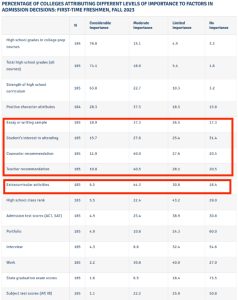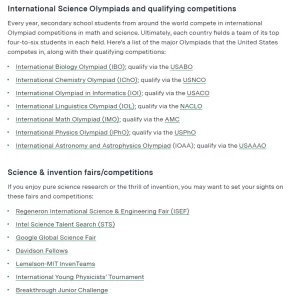18 Research Topics in Biology for High School Students
In recent years, background improvement has received more and more attention. First, famous American universities often use holistic admission (comprehensive evaluation method) when evaluating students' application materials. In addition to quantitative indicators, they also value students' personal abilities, ways of thinking, social responsibility, leadership, teamwork ability, etc.
The competition for admission has become increasingly fierce and complex, but the application backgrounds of students are often similar and lack individuality. It isn't easy to find highlights in improving GPA or extracurricular activities.
The National Admissions Counseling Committee (NACAC) has given a list of "admission factors", which are the standards American universities usually refer to when admitting international students.

Image credits:The National Admissions Counseling Committee (NACAC)
According to the report, it is very difficult for applicants to open up a gap with competitors in terms of GPA and language scores. If you want to be superior, you must look at your soft power! Admissions officers will favor your "strong interest" in a certain professional field in your application documents, and the most direct way to prove it is to have scientific research experience in this professional field.
Many top universities such as MIT, Harvard University, and Duke University have required in their admission announcements that applicants must provide relevant proof materials such as academic background.
As we all know, background improvement is a very important part of the application process for famous universities. After carefully studying the official websites of major universities, you can find that many "secrets" to winning offers are inseparable from scientific research experience.
Famous universities such as Harvard, Yale, and PMU are not only classrooms for imparting knowledge but also paradises for exploring the boundaries of human knowledge. The admissions officers' admission criteria are not simply to select "students with the best grades", but to find applicants with academic spirit and scientific research potential.

Image credits:Massachusetts Institute of Technology
Therefore, the manifestation of scientific research ability is the part that admissions officers are most interested in. Excellent scientific research experience can reflect personal quality and teamwork ability, and at the same time avoid the serious problem of homogeneity of domestic students. The school can predict academic performance and the possibility of future success through scientific research projects.We will cover what exactly a good research topic entails and then provide you with 25 possible physics research topics that may interest or inspire you.
what kind of background improvement project is a good project?
First, a good background improvement activity must be combined with the student's academic direction.
For a social issue, students can approach it from the perspective of their professional interests (psychology, media, economics, education, etc.), and further deepen their understanding of the major they will choose to study during the project.
Second, a good background enhancement activity must be combined with students' interests and hobbies.
Admissions officers want to see people with distinct labels, and activities that integrate personal interests can precisely reflect personal characteristics.
Many activities can be classified as hobbies, such as photography, skateboarding, cycling, hiking, Sudoku, Rubik's Cube, cooking, baking, knitting, Taekwondo, Jiu-Jitsu, etc.
When students are interested in a project, they tend to be more passionate. The output obtained by students who are passionate about an activity and those who participate in the activity just to complete the "task" are completely different.
Third, a good background enhancement activity must be down-to-earth and practical.
Many students are ambitious when choosing background enhancement activities, and like to choose remote places. For example, students in first-tier cities like to teach in remote mountainous areas, or even go abroad for activities, as if the farther they are, the more they can reflect their world feelings. Whether an activity is valuable has nothing to do with the distance of the location. American prestigious schools pay more attention to students' contributions to their communities.
Fourth, a good background-enhancing activity must be something that students persist in doing for a long time.
"Long-term" is an important criterion for identifying the value of volunteer activities internationally. The United Nations volunteer program usually requires service for more than one year. Through the duration and frequency of the activity, admissions officers can see the sincerity of the students for the activity. They can judge whether the students are doing this activity out of true love and sincerity, rather than for the sake of activities, or in other words, participating in these activities to apply to schools.
A long-term and planned activity is more likely to impress admissions officers, because continuous activities can have a lasting and far-reaching impact on themselves on the one hand, and on the other hand, it can better reflect the students' persistence and pursuit.
Research Ideas in Biology
We have compiled a list of 18 possible Biology research topics suggested by Embark PhD mentors. I hope you can learn from it.
- Establishment of psychological labels based on food satiety of adolescents
This research project focuses on exploring adolescents' psychological perception of the satiety of different foods and their relationship with food attributes. Through online surveys and laboratory tests, participants will experience specific foods and reflect their appetite responses through questionnaires, aiming to establish a psychological satiety label for food.
--Suggested by Embark PhD mentors at Yale University - Studying brain development in adolescents with depression based on structural MRI
This project aims to encourage researchers to study brain MRI imaging data of patients with depression from the perspective of adolescents, especially structural data, to explore the brain development characteristics of adolescent depression and its relationship with brain structural development, and provide a new scientific basis for the prevention and treatment of adolescent depression.
--Suggested by Embark PhD mentors at Rochester University - Study on the relationship between food reward mechanism and obesity and related diseases
This study aims to explore the causal relationship between food reward mechanisms and obesity and related diseases. This topic will deeply analyze the impact of food reward on individual food preferences through biomedical and psychological methods, and how this process may lead to the development of obesity and related health problems.
--Suggested by Embark PhD mentors at Harvard University - 3D culture: drug screening strategy for the multicellular 3D organoid culture of tumors
To simulate the microenvironment of tumors in vivo, we can add tumor-associated fibroblasts CAF for co-culture to form 3D multicellular tumor organoids. Through this platform, we can better evaluate the effects of drugs on tumors and provide a good bridge from cells to animals for drug development.
-Suggested by Embark PhD mentors at Princeton University - Assist brain science exploration through imaging technology
In recent years, people have used quantitative magnetic resonance imaging technology to explore the integrity and functionality of myelin sheaths, further unraveling the mysteries of the human brain. However, these imaging methods are highly complex and require long post-processing time, and further exploration is needed. In this project, we will explore relatively simple and fast imaging techniques or post-processing methods, hoping to assist in further exploration of brain science by seeking effective methods.
--Suggested by Embark PhD mentors at California University - Use AI to help the visually impaired identify colors
Globally, at least 2.2 billion people have impaired myopia or farsightedness, and a large proportion of them have difficulty distinguishing colors. This project aims to use AI technology and image processing to convert colors into sounds, thereby helping the visually impaired identify colors and complete daily tasks more easily and quickly.
--Suggested by Embark PhD mentors at Southampton University - Will drinking "zero sugar" beverages affect our learning and memory?
This project uses nematodes as a model organism. First, determine the effects of different concentrations of aspartame on learning and memory, then further study the genetic regulation of aspartame on nematode genes, determine the genetic mechanism of aspartame's effect on learning and memory, and finally determine the conservation of target genes and human homologous genes, and further explore the molecular mechanism of target gene regulation of learning and memory.
--Suggested by Embark PhD mentors at Pennsylvania State University - Application of UV photocatalysis technology in the removal of micropollutants from water
During the project, we will explore the principles and development of UV technology, its application in purifying water environments, and master the basic water environment and the distribution and hazards of micropollutants in water. Through experiments, we try to apply different UV treatment processes and catalysts to find suitable UV catalysis technology and experimental conditions.
--Suggested by Embark PhD mentors at Chicago University - Exploration of gender differences in sudden cardiac death
Sudden cardiac death is a common cause of death, but the incidence of this type of sudden death is significantly lower in women than in men. Exploring that women have a lower incidence of sudden death may be instructive for preventing sudden death. This project will summarize and discuss the gender risk differences of sudden cardiac death through literature research and explore the reasons for the gender differences.
--Suggested by Embark PhD mentors at Washington University - The code of twins
Are there twins around us? No matter how old they are, whether they are male or female, as long as there is a difference, it can be our research content. By comparing twins, we can find the underlying rules that affect important indicators such as human diseases, obesity, personality, growth, and even the code for immortality.
--Suggested by Embark PhD mentors at Oxford University - Research on the ecology and genetic diversity of the gut microbiome
In this project, our goal is to understand the community composition of the gut microbiome, investigate the factors that affect its function, and further explore the genetic diversity of the most common and diverse gut microbiome species.
--Suggested by Embark PhD mentors at Cambridge University - Using visual aftereffects to detect depression
The project will mainly reveal the degree of depression by using the brain's processing of visual aftereffects. First, experimental stimuli and paradigms are designed through the MATLAB psychology toolbox Psychtoolbox (PTB); second, psychophysical experiments and depression-related scales are conducted on the subjects; finally, the psychophysical and scale results are analyzed to find the correlation between the psychophysical results and the scales and items.
--Suggested by Embark PhD mentors at Johns Hopkins University - Preparation of highly specific and safe oncolytic viruses for hepatocellular carcinoma
In this study, we will design oncolytic viruses for hepatocellular carcinoma by targeting the oncogenic gene promoters, low pH, and hypoxic tumor microenvironment specific to hepatocellular carcinoma to reduce the impact on normal cells. At the same time, by optimizing the adhesion factor promoter and cleavage molecules, the lethality of oncolytic viruses will be enhanced.
--Suggested by Embark PhD mentors at Cornell University - Effects of sugar substitutes on gene expression in lipid metabolism pathways
Are sugar substitutes really a perfect substitute for white sugar? Compared with white sugar, do edible sugar substitutes have any effect on lipid metabolism? In this project, we will compare sugar substitutes with white sugar, observe their effects on lipid metabolism indicators in nematodes, and detect the differences in mRNA expression of genes related to lipid metabolism pathways.
--Suggested by Embark PhD mentors at Stanford University - 3D culture: drug screening strategy for a multicellular 3D organoid culture of tumors
2D cultured cells cannot accurately simulate the state and environment of tumors in vivo, especially solid tumors. We hope to use 3D culture technology to construct organoids of tumor cells. In order to simulate the microenvironment of tumors in vivo, we can add tumor-associated fibroblasts CAF for co-culture to form 3D multicellular tumor organoids.
--Suggested by Embark PhD mentors at the Institute of Biochemistry and Cell Biology, Chinese Academy of Sciences - Preparation of highly specific and safe oncolytic viruses for hepatocellular carcinoma
In this study, we will design oncolytic viruses for hepatocellular carcinoma by targeting the oncogene promoters, low pH, and hypoxic tumor microenvironment specific to hepatocellular carcinoma to reduce the impact on normal cells.
--Suggested by Embark PhD mentors at the Institute of Biochemistry and Cell Biology, Chinese Academy of Sciences - Study on Gut Microbiome Ecology and Genetic Diversity
In this project, our goal is to understand the community composition of the gut microbiome, investigate the factors that affect its function, and further explore the genetic diversity of the most common and diverse gut microbiome species.
--Suggested by Embark PhD mentors at Cambridge University - Transgenic Drought-Resistant Rice
Cow horn melon is a Yunnan-style medicinal plant that is drought-resistant, salt-alkali-resistant, and barren-resistant, and has strong research value. In this project, we will try to transfer the drought-resistant gene of cow horn melon into rice to explore whether a new type of drought-resistant rice can be obtained so that this important food crop can better cope with global climate change.
--Suggested by Editor-in-Chief of the international
Some of these research projects are also suitable for participating in international competitions such as Regeneron ISEF, Yau Science Award, and Regeneron STS.
If you are passionate or even curious about Biology and would like to do research and learn more, consider applying to the Embark Exploration Programs, which is a selective online high school program for students interested in research with the help of mentors. You can find the application form here.





